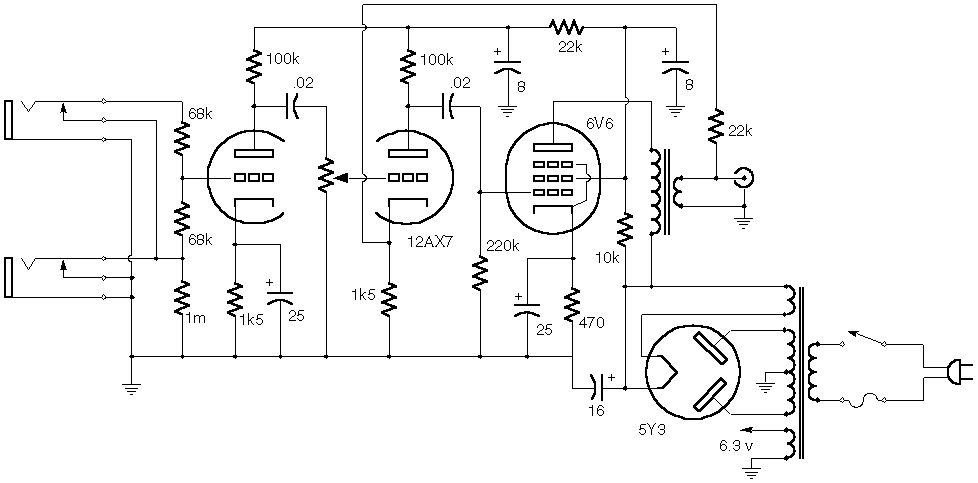#1 My head amp
Posted: Tue Mar 13, 2012 8:49 am
OK so it has been evolving. The kt88 output in pentode mode with one stage feedback (I can't try U/L don't have the right transformer) sounds about the same as kt88 triode mode without feedback. But has more power as expected and more low level detail across all the frequencies plus, punches out the music very fast. Attack good I think you would call that.
But there is sibilance and there is too much brightness tilt.
So I tried the 300b. Better middle tones but not significantly better enough, and not worth the loss of low level detail across the board compared to the pentode, (remember this amp doesn't need to go below 80hz) attack non existent next to the pentode. loudness not much less.
So then I tried the 801a. Much nicer, and a keeper, as good as the pentode at everything but with a better tone than the 300b. Obviously the flaw here is power output. Great for a practice amp. the pentode has enough power for a hotel lounge balad style gig or a small pub blues gig. Not enough for a prog rock gig. But I recon it would do stairway to heaven in a lot of rooms.
But the flaw in the design in terms of my hifi experiences is the sibilance and the peakyness. But these things possible accompany guitar amp designs.
My comments on output valves relate only with respect to this guitar amp circuit for the guitar. I have left my prejudices behind, it has been with the aim to improve the tone and retain the volume and the punch.
My next experiement which will take some time, will be to build the Rosenblit Glass Audio OTL once more. My memory of it in hifi terms was that it filled the room from ceiling to floor from wall to wall from corner to corner both ways with a huge wall of sound. It completely ibliterated what I was doing at the time with 300b SE, 813 SE 2a3 and 45. Left them sounding like little mice trying to occupy a small part of the room with sound.
SO I am thinking this attribute of filling a room with sound should bode well for a guitar amp.
I am hoping to recover some of the tone I am after by using my German Field coil speakers. If I make a 4 X 8" open baffle arrangement that looks like a standard guitar cabinet because it will be fully open backed, with grille cloth across the whole back. (The damping so provided may help things anyway).
They are 8 ohm each so with four in series I should get 40 watts or so.
Because the Rosenblit has global feedback I shall probably built a small lowish voltage valve preamp as a seperate plug in which will provide initially the overdrive sound, and later tremalo and reverb, I may incorporate tone controls.
We shall see how that works out.
Not sure where the sibilance is hiding at present but the guitar amp design breaks so many rules I am lost..
But there is sibilance and there is too much brightness tilt.
So I tried the 300b. Better middle tones but not significantly better enough, and not worth the loss of low level detail across the board compared to the pentode, (remember this amp doesn't need to go below 80hz) attack non existent next to the pentode. loudness not much less.
So then I tried the 801a. Much nicer, and a keeper, as good as the pentode at everything but with a better tone than the 300b. Obviously the flaw here is power output. Great for a practice amp. the pentode has enough power for a hotel lounge balad style gig or a small pub blues gig. Not enough for a prog rock gig. But I recon it would do stairway to heaven in a lot of rooms.
But the flaw in the design in terms of my hifi experiences is the sibilance and the peakyness. But these things possible accompany guitar amp designs.
My comments on output valves relate only with respect to this guitar amp circuit for the guitar. I have left my prejudices behind, it has been with the aim to improve the tone and retain the volume and the punch.
My next experiement which will take some time, will be to build the Rosenblit Glass Audio OTL once more. My memory of it in hifi terms was that it filled the room from ceiling to floor from wall to wall from corner to corner both ways with a huge wall of sound. It completely ibliterated what I was doing at the time with 300b SE, 813 SE 2a3 and 45. Left them sounding like little mice trying to occupy a small part of the room with sound.
SO I am thinking this attribute of filling a room with sound should bode well for a guitar amp.
I am hoping to recover some of the tone I am after by using my German Field coil speakers. If I make a 4 X 8" open baffle arrangement that looks like a standard guitar cabinet because it will be fully open backed, with grille cloth across the whole back. (The damping so provided may help things anyway).
They are 8 ohm each so with four in series I should get 40 watts or so.
Because the Rosenblit has global feedback I shall probably built a small lowish voltage valve preamp as a seperate plug in which will provide initially the overdrive sound, and later tremalo and reverb, I may incorporate tone controls.
We shall see how that works out.
Not sure where the sibilance is hiding at present but the guitar amp design breaks so many rules I am lost..
